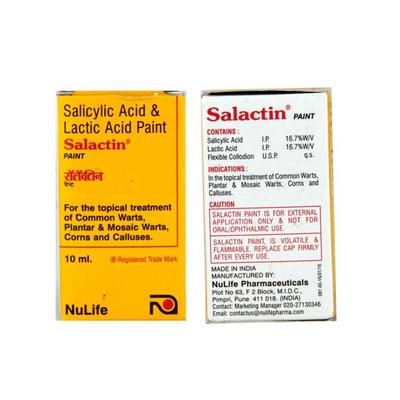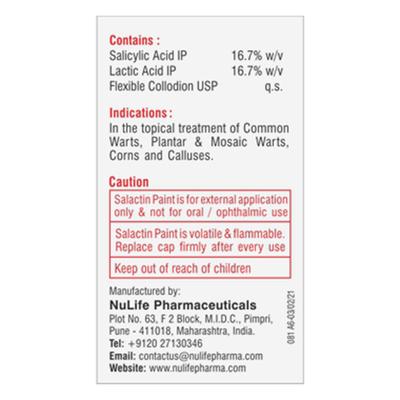

Netmeds First Membership
Quick Links
Introduction About SALACTIN PAINT
Salactin Paint is a collodion wart paint, used for the topical management of common warts, plantar and mosaic warts, corns, and calluses (small rough growths on the skin). It contains salicylic acid and lactic acid as active ingredients that remove the corns and warts effectively and painlessly without scarring the skin.
Salicylic acid has keratolytic properties that causes the breakdown of the keratin layer. Lactic acid enhances the availability of salicylic acid and helps in the breakdown of the skin's surface. On application, Salactin Paint dries and leaves a flexible film over the site of application.
Always apply Salactin Paint as advised by your physician. It is for external use only and not for oral or ophthalmic use. It can be safely used by children, adults and elderly.
Key Composition
- Salicylic Acid
- Lactic Acid
Therapeutic Uses Of SALACTIN PAINT
- For the topical management of common warts, plantar and mosaic warts, corns, and calluses
Side Effects Of SALACTIN PAINT
Consult your doctor if you notice any unusual side effects while using Salactin Paint.
Safety Advice
- Always apply Salactin Paint as advised by your physician
- Use it 1-2 times daily or as directed by your doctor
- Remove any adhesive plaster and soak the affected part in warm water for 5 minutes. Dry with your own towel
- Rub the softened area carefully and gently with a pumice stone or manicure emery board, to be used only for this purpose
- Apply Salactin Paint only to the affected region with the applicator, avoiding the surrounding normal healthy skin. Give a second application only after the first one is dried
- Wipe off any Salactin Paint spread on to the normal healthy skin with cotton wool
- Application to the soles of the feet should be covered with adhesive plaster when dried. Never walk barefoot
- Repeat the procedure after every 12 to 24 hours
- Do not use if you are allergic to any of its components
- It can be safely used by children, adults and elderly
- Inform your doctor on all the medicines you use, including prescription and over-the-counter medications, as well as herbal supplements
More Information
- Keep Salactin Paint out of reach of children
- Store at room temperature
FAQs About SALACTIN PAINT
Q: Can I use Salactin Paint if I am diabetic?
A: Do not use it if you are diabetic or have poor blood circulation to your hands or feet. Consult your doctor for further advice.
Q: What to do if Salactin Paint gets into normal skin?
A: If you accidentally get Salactin Paint on your normal skin, immediately wipe it off with a tissue and, if necessary, wash the area. If this occurs, apply a small amount and be extra careful not to get any on areas other than the affected area.
Q: What if I accidentally inhale Salactin Paint?
A: You might feel dizzy if you inhale a lot of the Salactin Paint vapour. Get lots of fresh air if this occurs and consult your doctor if dizziness persists.
Q: Can Salactin Paint cause irritation to my skin?
A: Unacceptable discomfort or persistent irritation can occur at the management area, but this is very rare. If this happens, stop using Salactin Paint and tell your doctor.
Q: Can we use Salactin Paint on face?
A: Salactin Paint is not recommended to use anywhere near or on the anal, genital area, bottom, breasts, armpits, or your face (such as on birthmarks, moles, warts with hairs growing out of them, or any other spot). Consult your doctor for further queries.
References
1. https://www.medicines.org.uk/emc/files/pil.3766.pdf
2. https://nulifepharma.com/p-products/85/salactin-paint









